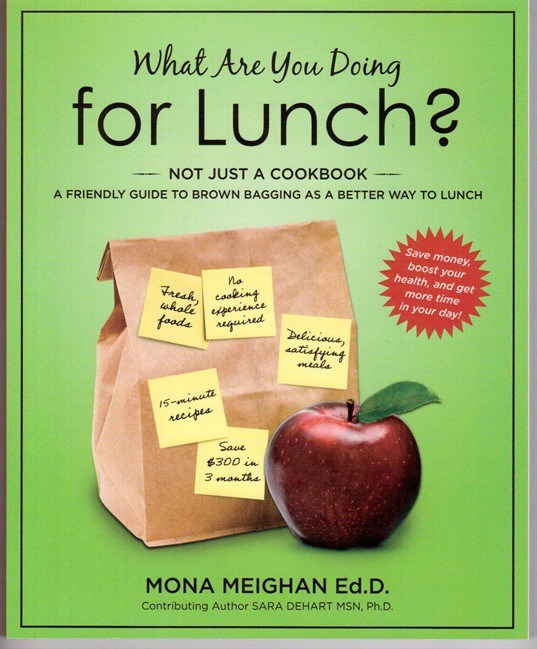TORONTO - Tightening purse strings and eating healthily are on the minds of many now that the holidays are over. Toting your lunch to work or school is a way to achieve both of those goals.
By taking a few minutes to do some preparation, you can create an entire week's worth of healthy lunches for the same price as eating in a restaurant just once, says Mona Meighan, author of "What Are You Doing for Lunch? A Friendly Guide to Brown Bagging as a Better Way to Lunch."
Plus you will know exactly what you're eating and have more control over quality, quantity, calories, fat, salt and sugar.
The inspiration for Meighan's book arose from a personal tragedy. Her 26-year-old son Luke died suddenly in 2009.
"When my son passed away from undiagnosed diabetes, as an educator I really felt like I wanted to do something," she said in an interview from Edmonds, Wash., just north of Seattle.
"And the something was to write a book that was easy to read, that was short, that was inexpensive and would help people understand that food is very important, no matter how old you are, to your health. My son had a normal diabetes reading two years before, and there was no diabetes in the family."
She writes in the foreword that Luke "was not known for his love of healthy food, but he did love to eat." His choices were mainly pizza, fast food, pop and sweet desserts.
She decided to focus on lunch, a meal often sacrificed due to lack of time.
In the book, Meighan shares more than 70 recipes using fresh, healthy ingredients that can be prepared in less than 20 minutes, though many can be made in far less time. Desserts have been omitted.
She provides projections of how much can be saved in a month and in a year, nutrition facts and a sample menu of lunches to get started.
If you're a person who buys lunch every day, the transition to brown-bagging may seem daunting. Treat it as you would an exercise program and start slow, making small changes consistently. Make your lunch a couple of days a week, for starters, then increase it. After about 30 days, it will become a habit.
"Your body starts realizing, 'I really like this, it's a good thing for me.' Bringing your lunch and eating your lunch regularly, your body likes it. It's a healthy thing to do," says Meighan.
As an educational consultant and former college professor, she's accustomed to looking at students' learning styles and extrapolated her experience into identifying personal lunch styles. She devised a quiz to help readers figure out which style suits them and has recipes devoted to each category.
For example, some people will spend 15 to 20 minutes the night before or morning of the workday to prepare a familiar lunch, like a ham and cheese sandwich. These are traditionalists. Others just grab a container of food — perhaps something put together over the weekend, or last night's leftovers — and hit the road. Meighan calls this the grab-and-go style.
There's also the creative lunch maker (not afraid to experiment with some variations or new recipes), the midday gourmet (stews, pasta dishes and more complex sandwiches involving more preparation), the social networker who likes to co-ordinate a group lunch, or a mix of the above, depending on what the week looks like.
Meighan's style is grab and go, while her partner is a traditionalist. He will make the same thing every single day for lunch.
"I tried to figure out what are these things that people make all the time and I added some recipes that were just a little bit different."
For instance, do something as simple as adding chopped apples and walnuts to tuna salad for variety.
For office workers who may find themselves regularly going out for lunch and spending more money than they should because everybody else is doing it, Meighan suggests the social networking plan.
"Think about it as a group and say, 'Well, you know, maybe we could go to a park for lunch if it's nice.'"
In a group of five, one person could take turns bringing five lunches each weekday or each person could bring some of the ingredients each day and pool them. For example, one person could bring hummus, another some pita bread, the third person vegetables for dipping, the fourth person a vegetarian taco salad, and the fifth fruit and yogurt.
"It really comes out cheaper," Meighan notes.
Meighan says most recipes in this book cost about one-third of what you would pay for an equivalent meal in a restaurant.
She advises using similar ingredients during the same week to cut down on expenses and food waste. Purchase recyclable containers to hold your food, if needed.
Meighan's website includes downloadable lists of ingredients, recipes and grocery shopping tips.
Once you become more adventurous, consult the Internet for recipes for fabulous gourmet lunches. "I encourage that. Once you get in the habit, there are incredible lunches out there. Just Google and you can get them."
She is working on a new cookbook featuring gluten-free recipes.
—â¶Ä”â¶Ä”
Online:
http://www.whatareyoudoingforlunch.com



